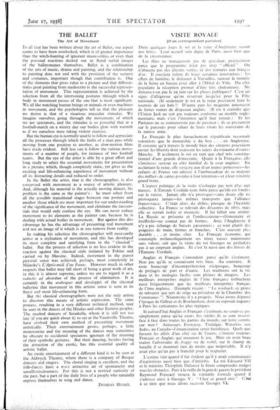THE BALLET
The Art of Movement
IN all that has been written about the art of Ballet, one aspect seems to have been overlooked, which is of greater importance than the witch-hunting of ignorant music-critics or even than the personal reactions decked out in florid verbal images of the balletomanes themselves. Ballet is a combination of the arts of music, drama and painting, and the relationship to painting does not end with the provision of the scenery and costumes, important though that contribution is. One of the elements that gives value to a picture and that differen- tiates great painting from mediocrity is the successful represen- tation of movement. This representation is achieved by the selection from all the intervening postures through which a body in movement passes of the one that is most significant. We all like watching human beings or animals or even machines in movement, and the psychologists tell us that the pleasure we derive is that of a vicarious muscular stimulus. We imagine ourselves going through the movements of which we are spectators, and the stimulus is so powerful that at a football-match on a wintry day our bodies glow with warmth as if we ourselves were taking violent exercise.
But the human eye is normally unable to follow and appreciate all the processes through which the limbs of a man pass while moving from one position to another, as slow-motion films have made evident. Still less can it follow the various move- ments of a number of people, for instance of two football teams. But the eye of the artist is able by a great effort and long study to select the essential movements for presentation in a picture, which, though completely static, yet gives us the exciting and life-enhancing experience of movement without all its distracting details and reduced to order.
In the Ballet the artist, that is the choreographer, is also concerned with movement as a source of artistic pleasure. And, although his material is the actually moving dancer, his problem is the same as the painter's : he must select from all the possible transitional stages between one posture and another those which are most important for our understanding of the significance of the movement, and eliminate the inessen- tials that would only confuse the eye. He can never reduce movement to its elements as the painter can, because he is dealing with actual bodies in movement. But against this dis- advantage he has the advantage of presenting real movement and not an image of it which is at one remove from reality.
In making his selection the choreographer will necessarily arrive at a stylisation of movement, and this has developed its most complete and satisfying form in the " classical " ballet. But the process of selection is no less evident in the reaction against the classical style initiated by Fokine and carried on by Massine. Indeed, movement in the purest pictorial sense was achieved, perhaps, most completely in Nijinsky's L'Apres-midi d'un: Fauna. However much in other respects that ballet may fall short Of being a great work of art, in this it is almost supreme, unless we are to regard it as a reductio ad absurdum of the process of elimination. It is certainly in the arabesques and developpes of the classical ballerina that movement in this artistic sense is seen in its finest and most life-enhancing form.
But the classical choreographers were not the only artists to discover this means of artistic expression. The same process, resulting in a very different technical method, may be seen in the dances of the Hindus and other Eastern peoples. The masked dancers of Seraikella, whom it is still not too late (if you are quick about it) to see at the Vaudeville Theatre, have evolved their own method of presenting movement artistically. Their entertainment grows, perhaps, a little monotonous and the meaning of the dances may sometimes be obscure to occidental spectators ignorant of the meaning of their symbolic gestures. But their dancing, besides having the attraction of the exotic, has this essential quality of artistic ballet.
An exotic entertainment of a different kind is to be seen at the Aldwych Theatre, where there is a company of Basque dancers and singers. The choral singing is excellent, and the folk-dances have a it °A attractive air of spontaneity and unselfconsciousness. For this is not a revived curiosity of the past, but a part of the daily lives of a people who naturally express themselves in song and dance.
DYNELEY HUSSEY.


















































 Previous page
Previous page